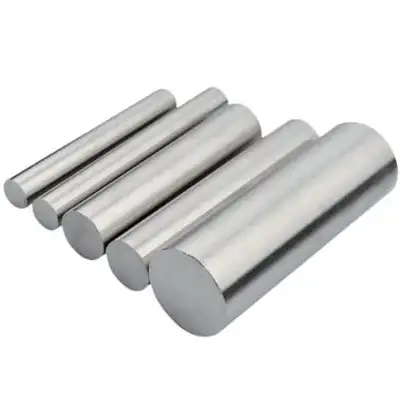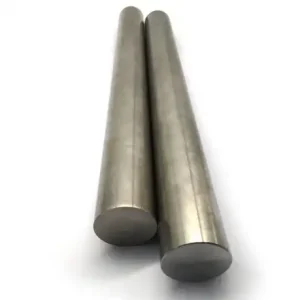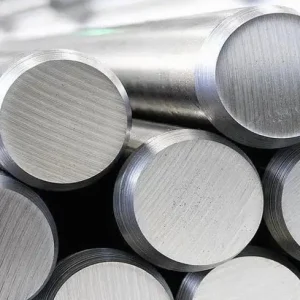A-286 stainless steel round bar (UNS S66286, sometimes marketed as Alloy 660 or Incoloy® A-286) is a precipitation-hardenable iron-nickel-chromium superalloy that blends high strength at elevated temperatures with good oxidation and corrosion resistance; for parts that require sustained performance up to roughly 704°C (1300°F), A-286 is often the preferred choice. For buyers who need certified AMS/ASTM stock in bar form — particularly for aerospace fasteners, turbine hardware, high-temperature springs, or critical industrial parts — procuring solution-annealed and properly aged A-286 round bar from a reliable mill or factory stockist will deliver predictable mechanical performance and rapid lead times.
What is A-286?
A-286 is an iron-based austenitic superalloy strengthened by precipitation and cold work. It contains significant nickel and chromium with additions of titanium and molybdenum that permit precipitation hardening, yielding a combination of high tensile strength, good notch-rupture resistance, and reasonable corrosion resistance for elevated temperature service. The alloy is standardized widely under AMS and ASTM specifications for bar, rod, plate, and tubing, which makes it a common selection for aerospace and industrial high-temperature hardware.
Typical chemical composition and microstructure
Below is a practical composition table reflecting the commonly supplied A-286 (EN 1.4980 / UNS S66286) used in bar stock. Small composition adjustments exist between suppliers and AMS/ASTM variants; purchase grade must match the applicable specification on the PO.
| Element | Typical range (wt%) |
|---|---|
| Iron (Fe) | Balance |
| Nickel (Ni) | ~24–26 |
| Chromium (Cr) | ~14–16 |
| Titanium (Ti) | ~1.8–2.3 |
| Molybdenum (Mo) | ~1.1–1.6 |
| Vanadium (V) | ~0.2–0.4 |
| Carbon (C) | ≤0.07 (typical ~0.04) |
| Manganese (Mn) | ≤1.0 |
| Silicon (Si) | ≤0.8 |
| Boron (B) | trace (~0.002–0.006) |
Microstructure in the solution-treated condition is austenitic and relatively ductile; after controlled aging, fine precipitates (titanium-rich phases) strengthen the matrix while maintaining ductility suited for high-stress fasteners and springs. The chemical ranges and precipitation hardening behavior are documented in multiple mill datasheets.
Key mechanical and physical properties
Typical values vary with condition (solution treated, cold worked, aged). Below are representative figures engineers commonly use for initial design or material selection; always confirm with the mill MTC for project-specific numbers.
-
Density: ~7.92 g/cm³ (0.286 lb/in³).
-
Elastic modulus: ~199 GPa (≈28.8 ×10⁶ psi).
-
Usable temperature range: cryogenic service down to −196°C and continuous elevated service to roughly 704°C (1300°F) for many applications; short excursions higher may be tolerated depending on oxidation environment.
-
Typical tensile (solution + aged/cold-worked conditions): ultimate tensile strength can reach 150–205 ksi (≈1035–1414 MPa) depending upon degree of cold work and aging recipe.
-
Notched rupture strength: A-286 has favorable notch rupture properties relative to other stainless families, which is why it is chosen for high-stress fasteners.
Note: The final mechanical signature depends strongly upon the exact AMS/ASTM variant and post-processing. For critical parts, require the supplier to supply full MTCs showing condition, hardness, tensile, and heat treatment records.
Heat treatment and aging
A-286 is solution annealed, then aged to develop peak strength. Typical factory procedures used by mills or heat-treat vendors:
-
Solution treatment: ~980–1038°C (1800–1900°F), rapid quench (oil or air depending upon form).
-
Aging: common practice is hold at ~650–760°C (1200–1400°F) for periods that may vary (commonly 8–24 hours) then air cool. One benchmark aging cycle is 718°C for 16 hours followed by air cool, used to produce strong precipitation hardening. Some strength/ductility tradeoffs are tuned by varying time and temperature.
Practical notes:
-
Avoid over-aging if the component must retain ductility.
-
Cold forming prior to aging can increase final strength but requires careful process control.
-
Welding typically introduces HAZ embrittlement risk; many vendors advise avoiding fusion welding for load-bearing parts, or using alternative alloys for welded assemblies.
Forms, tolerances and typical round bar sizes (specs: AMS / ASTM)
A-286 is stocked and specified under several standards. Common controls used on purchase orders:
-
Bar / rod: AMS 5731, AMS 5732, AMS 5734, AMS 5737.
-
Sheet/strip: AMS 5525, AMS 5858.
-
ASTM/ASME: ASTM A638 / ASME SA-638 used for rod/bar in some markets.
-
UNS / W. Nr: UNS S66286 / W.Nr 1.4980.
Typical diameters available from distributors range from small bright bars (≈3–10 mm) up to heavy round bars (>300 mm), with common stock diameters in the 6–150 mm range for quick delivery. For aerospace fasteners, cold-drawn and ground tolerances are available per AMS grades.
Fabrication notes: machining, cold work, forging and welding cautions
-
Machining: harder than common stainless grades; cemented carbide tooling and conservative feeds/speeds give best tool life. Vendors publish recommended feeds and cutting data for A-286.
-
Cold working: alloy work hardens; pre-solution annealing prior to heavy forming reduces fracture risk.
-
Forging: hot forging range roughly 1038–1121°C with limitations; do not forge below recommended lower limit to prevent cracking.
-
Welding: fusion welding risks HAZ cracking and re-precipitation that can affect mechanical properties; many fabricators avoid welds in high-stress parts or substitute weld-friendly alloys (or use specialized filler metals and post-weld heat treatment). When welding is necessary, consult the metal producer for qualified procedures.
Typical applications and failure modes
Common uses for A-286 round bar include: aerospace fasteners and studs, gas turbine components, high-temperature springs and retaining rings, compressor parts, supercharger hardware, and some downhole/oilfield components where high strength and oxidation resistance are demanded. Typical failure modes to watch for in service: creep at prolonged high temperature if stressed near allowable limits, stress-corrosion cracking in aggressive chemistries, and fatigue where surface quality or notches exist. Design engineers should evaluate operating environment, cyclic loading spectrum, and chemical exposure when selecting A-286.
Corrosion, oxidation and temperature limits
A-286 combines oxidation resistance similar to Type 310 stainless at certain temperatures and provides reasonable resistance to chlorides and general industrial atmospheres, though no alloy is immune to all environments. For long service in strongly acidic or chloride-rich conditions, consider more corrosion-resistant alloys or protective coatings. For oxidation behavior and specific limits, consult the mill datasheet for the alloy condition used in the part.
Quality control, traceability, and relevant specifications
For critical components, include these procurement controls:
-
Specify AMS/ASTM / UNS number on PO. (e.g., AMS 5731 / UNS S66286).
-
Request full mill test certificates (MTC / EN 10204 3.1 or 3.2) covering chemistry, tensile, hardness, and heat treatment records.
-
Non-destructive testing (NDT) protocols if parts will be used in aerospace or safety-critical roles.
-
Batch traceability linking final parts back to melt numbers and heat treatment records — mandatory for regulated sectors.
2025 global pricing comparison
Price transparency for specialty alloys varies by order quantity, mill source, certification and form. Below are representative 2025 retail/distributor ranges for small/medium orders (per kg); bulk mill orders and long contracts will differ. Use these figures as starting points; request formal quotes for fixed pricing.
| Region | Typical 2025 retail/distributor range (USD / kg) | Notes / source |
|---|---|---|
| China (domestic mills / trading portals) | USD $5 – $35 / kg | wide range depending on grade, finish, MOQ; multiple Made-in-China listings. |
| India (local stockists & fabricators) | USD $22 – $65 / kg | Indian stockist price lists show varied pricing by AMS spec and size. |
| Europe (distributors, small qty) | USD $25 – $120 / kg | European distributors and specialty suppliers typically charge a premium for traceability and small runs. (example distributor catalogs). |
| USA (distributors & online sellers) | USD $40 – $200 / kg | Online retailers show sheet/plate pricing that converts to high per-kg values for small pieces; aerospace-grade certified bars command higher rates. |
Why the wide ranges? Quantity, certification level (AMS/ASTM / certificate type), machining/ground finish, diameter, and current raw-material input costs explain most variation. For small prototype buys, expect distributor premiums; for contract volumes, negotiate mill direct pricing.
Buying checklist — what procurement should require
-
Exact alloy designation (UNS S66286 / EN 1.4980) and AMS/ASTM spec on PO.
-
Required condition (solution treated, cold-drawn, aged) and hardness/Tensile min values.
-
MTC type (EN 10204 3.1/3.2) and full chemistry.
-
Heat number traceability from melt through heat treatment.
-
Surface finish and dimensional tolerances (ground, turned, bright).
-
NDT or test coupons if needed for qualification.
-
Packaging, delivery lead time, and Incoterm.
-
Warranty/return policy for non-conforming material.
FAQs
-
What is the correct UNS number for A-286?
UNS S66286 (EN W.Nr 1.4980). -
Which standards govern bar and rod for A-286?
Common standards include SAE/AMS 5731, AMS 5732, AMS 5734, AMS 5737 and ASTM A638/ASME SA-638 for certain forms. Specify the exact AMS/ASTM number on purchase orders. -
Can A-286 be welded for load-bearing parts?
Welding poses HAZ cracking risks for load-bearing parts. Where welding is unavoidable, use qualified procedures, special filler metals, or consider alternate alloys designed for welded structures. -
What maximum continuous temperature is recommended?
Typical continuous service is up to ~704°C (1300°F); oxidation resistance at higher transient temperatures depends on environment and component geometry. -
Is A-286 magnetic?
In the annealed solution-treated condition, it is largely austenitic and non-magnetic. Cold working and some aging conditions can introduce magnetic response due to phase changes. -
How is peak strength achieved?
By solution annealing followed by carefully controlled aging to precipitate fine Ti/Mo-rich phases; cold work prior to aging increases achievable strength. -
What typical lead time should buyers expect from Chinese mills for stocked bar?
For stocked diameters, mill/ex-stock deliveries can be under 7–14 days; custom sizes, certified AMS lots and large orders require longer lead time and scheduling. Market conditions affect timing. -
Are there common equivalents to A-286?
A-286 is fairly unique in its balance of iron-base chemistry with precipitation hardening. Some alloys deliver similar high-temperature strength but differ in corrosion resistance; always confirm chemical and mechanical equivalence before substitution. -
What test certificates should be mandatory for aerospace purchases?
EN 10204 Type 3.1 or 3.2 certificates, full MTC showing melt number, chemistry, tensile and hardness data, heat treatment record and applicable AMS/ASTM conformance. -
For small prototype orders, how can cost be reduced?
Use non-certified commercial stock for development, order slightly larger batch sizes to amortize tooling/processing, or opt for domestic distributor stock with longer lead times but lower per-piece premiums.
why choose MWAlloys for A-286 round bar
MWAlloys is a China-based specialist for high-performance alloy stock and processing. For A-286 round bar we offer:
-
Factory sourcing and direct pricing: 100% factory-level quotations that avoid distributor markups, enabling better margins for OEM buyers.
-
Quick stock delivery: Typical stocked diameters available for rapid shipment from our China warehouses; cutting and custom lengths offered.
-
Certs on demand: Full mill test certificates, AMS/ASTM traceability and inspection documentation for regulated sectors.
-
Small to large volumes: Prototype quantities through long-term contract volumes handled with consistent metallurgical practice.
When contacting MWAlloys, include the AMS/ASTM spec, required diameter/length, and any special heat-treatment or tolerancing needs to receive a firm quote.
Practical purchasing tips and risk mitigation
-
Always require an MTC. Accepting undocumented material increases risk.
-
Inspect surface finish and hardness on delivery. Surface defects or incorrect hardness often indicate incorrect processing.
-
Specify acceptance criteria for dimension and straightness. For precision fasteners, ground and centerless-ground bars are recommended.
-
Use small qualification lots before committing to long runs for safety-critical parts.
-
If welding is planned, request weld procedure qualifications from the mill or a third-party lab.





